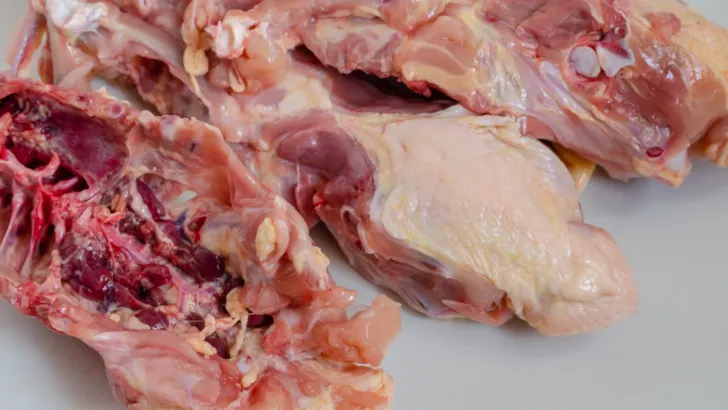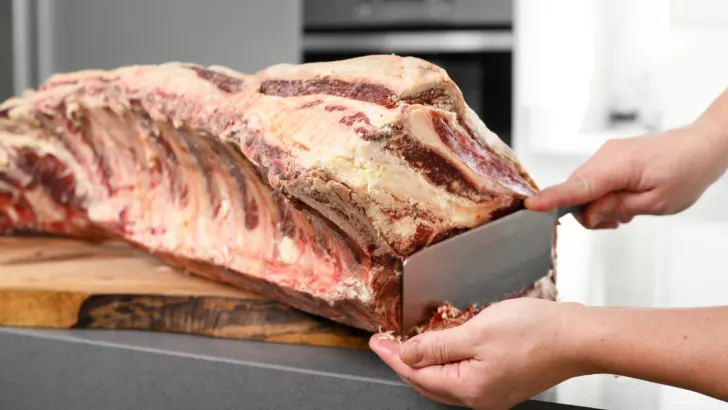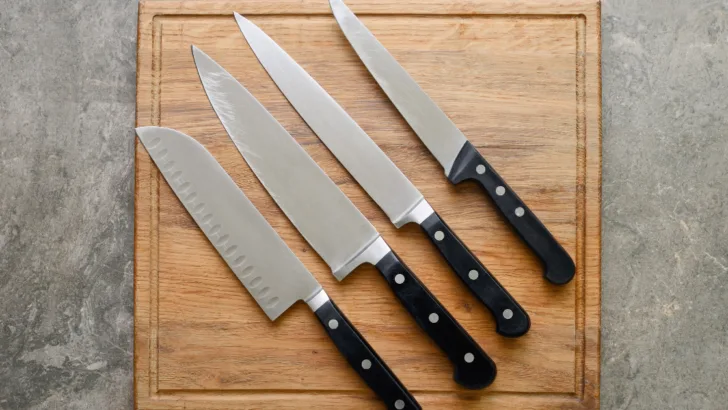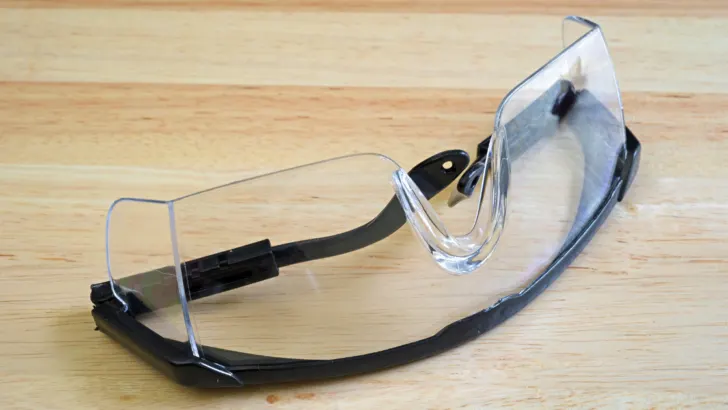What Is Bone? And can a kitchen knife cut through bone?

Bone Cutting Demystified: Kitchen Knife vs. Bone Challenge
As someone who loves to cook and finds cooking therapeutic and a work of art, I am often asked (aswell as cooking tips!), can a kitchen knife cut through bone, I know that cutting through bone can be a challenge. But before we dive into to explore the question and what the best knives are for the job, let’s take a closer look at what bone actually is and some interesting facts.
Bone is a hard, dense tissue that makes up the skeleton of vertebrates. It is composed of two types of tissue: compact bone and spongy bone. Compact bone is the dense outer layer that gives bone its strength, while spongy bone is the inner layer that contains bone marrow.
Bones are constantly changing and remodeling throughout our lives. They are made up of living cells that are constantly breaking down and rebuilding bone tissue. This process is called bone remodeling and it helps to maintain bone strength and structure.
While bones are incredibly strong and durable, they can still be damaged or broken. This is why it’s important to handle them carefully when preparing food. Cutting through bone requires a sharp knife and a bit of force, but it can be done safely and effectively with the right tools and technique.
In summary, bone is a hard, dense tissue that makes up the skeleton of vertebrates. It is composed of compact and spongy bone tissue and is constantly changing and remodeling throughout our lives. When preparing food, it’s important to handle bones carefully and use the right tools for the job.
Why Might You Want to Cut Through Bone with a Kitchen Knife?

Cutlery Capabilities: Assessing the Bone-Cutting Potential
As someone spends alot of time in the kitchen, I often find myself in situations where I need to cut through bone using a kitchen knife. Here are some reasons why you might want to do the same:
- Better Flavor and Nutrition
When cooking meat, bones can add a lot of flavor and nutrition to your dishes. Cutting through the bone with a kitchen knife can help you create bone-in cuts of meat that are more flavorful and nutritious than boneless cuts.
- Cost Savings
Bone-in cuts of meat are often less expensive than boneless cuts. By cutting through the bone yourself using a kitchen knife, you can save money on your grocery bill and get more meat for your money.
- Versatility
A kitchen knife that can cut through bone can be a versatile tool in the kitchen. It can be used to cut through not only meat bones but also fish bones and even some vegetables. This can save you time and effort in the kitchen, as you won’t need to switch between different knives for different tasks.
- Control
When you cut through bone with a kitchen knife, you have more control over the size and shape of your cuts. This can be especially important when preparing meat for dishes like stews or soups, where uniformity is important for even cooking.
- Satisfaction
There is something satisfying about being able to cut through bone with a kitchen knife. It can make you feel like a skilled and accomplished cook, and can add an element of excitement to your cooking experience.
Overall, cutting through bone with a kitchen knife can be a useful and rewarding skill for any home cook to have. With the right knife and technique, you can create flavorful, nutritious, and versatile dishes that are sure to impress your family and friends.
What Are the Risks of Cutting Through Bone with a Kitchen Knife?

Carving Confidence: Understanding Your Kitchen Knife’s Bone-Cutting Capacity
When it comes to cutting through bone with a kitchen knife, there are several risks that one should be aware of. As someone who enjoys cooking at home, I have learned the hard way that cutting through bone can be dangerous if not done properly.
Firstly, using a kitchen knife to cut through bone can damage the blade. Bones are hard and can cause the blade to dull quickly or even chip. This can be dangerous as a dull or chipped blade can slip and cause injury. It is important to use a knife that is specifically designed for cutting through bone, such as a cleaver.
Secondly, cutting through bone can be physically demanding and can cause strain on your hands and wrists. This is especially true if you are using a knife that is not designed for cutting through bone. It is important to use proper technique and take breaks if necessary to avoid injury.
Lastly, cutting through bone can pose a risk of bacterial contamination. When cutting through bone, the knife can come into contact with bone marrow, which can contain harmful bacteria. It is important to thoroughly clean and sanitize the knife and cutting board after cutting through bone to avoid the risk of foodborne illness.
Overall, cutting through bone with a kitchen knife can be risky if not done properly. It is important to use a knife that is specifically designed for cutting through bone, use proper technique to avoid injury, and thoroughly clean and sanitize the knife and cutting board to avoid the risk of bacterial contamination.
Types of Knives for Cutting Through Bone

Bone-Cutting Challenge: Testing Kitchen Knife Performance
When it comes to cutting through bone, not all knives are created equal. Here are the three main types of knives that are commonly used for cutting through bone:
Boning Knife
A boning knife is a thin, sharp knife that is designed to remove bones from meat. It has a narrow, flexible blade that allows you to get in between the bones and the meat. While a boning knife can be used to cut through smaller bones, it may not be the best choice for larger bones.
Cleaver
A cleaver is a heavy, rectangular knife that is designed to chop through bones and other tough materials. It has a thick, sturdy blade that can withstand the force required to chop through bone. A cleaver is a great choice for cutting through larger bones, such as beef or pork bones.
Serrated Knife
A serrated knife is a knife with a saw-like edge that is designed to cut through tough materials, such as bread or meat with bones. The serrations on the blade help to grip the bone and cut through it more easily. A serrated knife can be a good choice for cutting through smaller bones, such as chicken bones.
When choosing a knife for cutting through bone, it’s important to consider the type of bone you’ll be cutting, as well as the size and thickness of the bone. A heavier knife, such as a cleaver, is designed to handle tasks like cutting through bone, while a lighter knife, like a boning knife or a serrated knife, may not be as effective.
Techniques for Cutting Through Bone

A Slice of Reality: Can Your Kitchen Knife Tackle Bones?
Cutting through bone requires a different technique than cutting through meat or vegetables. There are two main techniques for cutting through bone: sawing and chopping.
Sawing

Sharpened for Success: Exploring Kitchen Knife Bone-Cutting Skills
When sawing through bone, I prefer to use a sawing motion rather than a chopping motion. This is because a sawing motion is less likely to damage the blade of the knife. To saw through bone, I hold the knife at a slight angle and make small back and forth sawing motions. This technique allows me to gradually work my way through the bone without putting too much pressure on the blade.
Chopping

Bone Cutting 101: Testing Your Kitchen Knife’s Strength
Chopping through bone requires more force than sawing. When I need to chop through bone, I prefer to use a cleaver rather than a regular kitchen knife. A cleaver has a thicker and heavier blade that can handle the force required to chop through bone. To chop through bone, I hold the cleaver with a firm grip and position it above the bone. Then I strike down with force, applying a strong, controlled force to cut through the bone. I repeat this as necessary until the bone is fully separated.
In summary, cutting through bone can be done with either a sawing or chopping motion depending on the type of bone and the knife being used. Sawing is a more gentle technique that is less likely to damage the blade, while chopping requires more force and is best done with a cleaver. By using the right technique and knife, cutting through bone can be done with ease and precision.
Safety Tips
Use a Sharp Knife

Can It Cut? Bone Edition: Analyzing Kitchen Knife Performance
When it comes to cutting through bone, it’s important to use a sharp knife. A dull knife requires more force, which increases the risk of slipping and injuring yourself. I always make sure to keep my knives sharpened using a sharpening stone or knife sharpener. This helps maintain the original precision of the blade and makes cutting through bone easier and safer.
Use a Firm Grip

Knife Performance Under Pressure: Bone-Cutting Abilities Revealed
To prevent the knife from slipping, it’s important to have a firm grip on the handle. I always make sure my hands are dry and free of any oils or grease before handling a knife. I also hold the knife with my fingers wrapped firmly around the handle and my thumb resting on the spine of the blade for added control.
Cut Away from Your Body

Beyond Vegetables: Unleashing Your Knife’s Bone-Cutting Potential
When cutting through bone, it’s important to cut away from your body to avoid any accidental injuries. I always make sure to position the bone on a cutting board and cut in a direction that moves the knife away from my body. This helps prevent the knife from slipping and injuring myself.
Wear Safety Glasses

Always safety first – when handling kitchen knifes
When cutting through bone, small bone fragments can sometimes fly off and hit you in the eye. To prevent any eye injuries, I always wear safety glasses when cutting through bone. This helps protect my eyes from any flying bone fragments and ensures that I can safely and confidently cut through bone.
Remember, cutting through bone can be dangerous if not done properly. By following these safety tips, you can ensure that you stay safe while cutting through bone and avoid any potential injuries.
Frequently Asked Questions
What type of knife is best for cutting through bones?
When it comes to cutting through bones, a sharp, sturdy, and heavy-duty knife is ideal. A boning knife or a cleaver is the best type of knife for this task. A boning knife is thin and flexible, which allows for precise cuts around bones. On the other hand, a cleaver has a thick and heavy blade that can cut through bones with ease.
Is a meat cleaver the only knife used for cutting through bones?
No, a meat cleaver is not the only knife used for cutting through bones. While a meat cleaver is a popular choice, a boning knife, a chef’s knife, and a fillet knife can also be used to cut through bones. However, it’s important to note that not all knives are designed to cut through bones, and using the wrong knife can damage the blade or cause injury.
Are all types of knives capable of cutting through bones?
No, not all types of knives are capable of cutting through bones. Knives with thin and flexible blades, such as paring knives or slicing knives, are not designed to cut through bones. Using these types of knives to cut through bones can damage the blade or cause injury.
Can an electric knife cut through bones?
Yes, an electric knife can cut through bones, but it’s important to use the right blade. Electric knives with serrated blades are ideal for cutting through bones. However, it’s important to note that electric knives are not as precise as manual knives, and they can be difficult to control when cutting through bones.
What is the best tool for cutting through bones?
The best tool for cutting through bones depends on the type of bone and the cut you want to make. For larger bones, a meat cleaver or a heavy-duty knife is ideal. For smaller bones, a boning knife or a fillet knife can be used. It’s important to choose the right tool for the job to ensure safety and precision.
How sharp does a blade need to be to cut through bones?
A blade needs to be very sharp to cut through bones. A dull blade requires more force, which can increase the risk of slipping and injuring yourself. It’s important to sharpen your knife before using it to cut through bones. Additionally, a sharp blade will make cleaner cuts, which will result in better-looking cuts of meat.
I hope this article has been helpful. If you have any questions, please feel free to leave a comment below.
